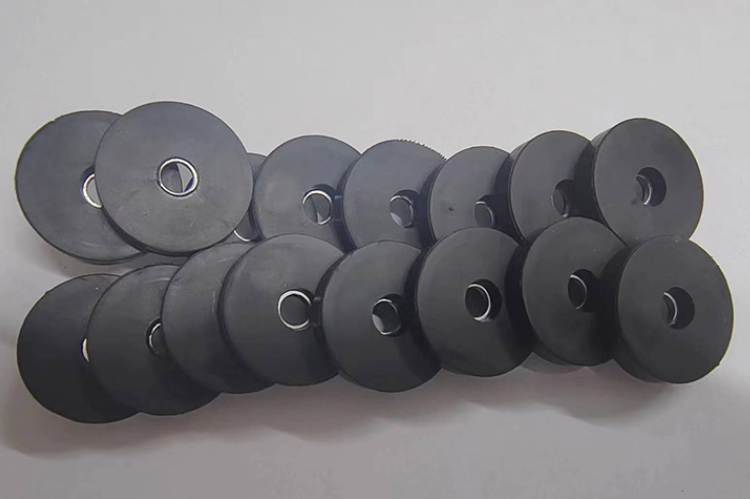The surface of rubber coated (rubber covered) magnet suction cups is covered with synthetic rubber material, which is not only waterproof, but also has very good resistance to damage, unlike ordinary magnets which are prone to breakage. They are very durable and the rubberized material enhances the horizontal friction and prevents them from sliding on the mounting surface. The rubber material covering the exterior of the magnet suction cups has very good physical and chemical properties, we have different grades to choose from, some have very good UV resistance, some have excellent oil resistance, some have outstanding environmental performance, etc., through the addition of different trace components, but also to enable the rubber to achieve other different characteristics.
Rubber coated neodymium magnets

For applications that require long-term exposure to outdoor sunlight, corrosive gases and liquids, oil and dirt, etc., you will find the right choice in our adhesive-coated magnet suction cups. According to the 12 years of long-term measurement and research by Zhongke Sannhuan Research Institute, the service life of NdFeB magnet can be more than 30 years, or even 50 years with very little loss of magnetism. As the magnet inside the rubber-coated magnet suction cup is completely protected by the rubber outside, isolated from air and water, so even if used for a long time, the magnet will not corrode, thus making the magnetic adsorption function can be maintained for a long time. For the exposed threaded holes, bolts, etc., as well as the metal parts inside the rubberized layer, special anti-corrosion treatment can be used, or stainless steel, to ensure its service life. This ensures the long service life of the entire product and meets the durability requirements of products in harsh environments. The maximum working temperature of the overmolded magnet can be up to 80 degrees Celsius, and the minimum working temperature can be up to minus 40 degrees Celsius, which can meet most of the use of the scene.
Here are some factors that affect the durability of adhesive-coated magnets;
Material quality: the magnetic properties of overmolded magnets depend largely on the quality of the magnetic material. Higher quality magnetic materials usually have better durability and are able to maintain their magnetic properties for a longer period of time.
Manufacturing process: Temperature, pressure and process control during manufacturing also affect the performance of overmolded magnets. A quality manufacturing process ensures uniformity and stability of the material, resulting in increased durability.
Conditions of Use: The conditions of use of overmolded magnets can have a significant impact on their longevity. High temperatures, humidity, acidic and alkaline environments, as well as strong mechanical shocks may shorten the life of the magnet. Therefore, when selecting and using overmolded magnets, you need to consider the factors of the environment you are in.
Maintenance: Proper maintenance can extend the life of overmolded magnets. Regular cleaning and maintenance, avoiding drastic temperature changes and mechanical damage all help to maintain their performance.
Overall, rubber coated magnets can have long durability under the right conditions, but may experience faster degradation in harsh environments. Therefore, proper selection, use and maintenance are all important factors in ensuring the durability of overmolded magnets. If more specific advice is required, it is best to consult the manufacturer or supplier as they can provide detailed information and advice on specific products.
Several common types of rubber-coated magnets;
 China Neodymium And Ferrite Magnets Manufacturer & Supplier
China Neodymium And Ferrite Magnets Manufacturer & Supplier 


